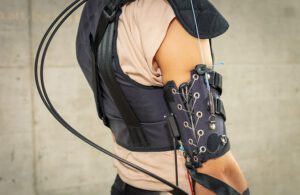
Marie Georgarakis demonstrates her Myoshirt exomuscle device. [Photo by Florian Haufe for ETH Zurich]
ETH Zurich researchers have redefined the muscle shirt.
Marie Georgarakis, a former doctoral student at ETH Zurich’s Sensory Motor Systems Lab, is the creator of the Myoshirt, a wearable, textile robotic device that helps users lift their arms and reach. A motorized cable works like an artificial tendon, directed by sensors and an algorithm to support the wearer’s intended movement.
ETH Zurich researchers recently tested Myoshirt on a dozen people — one person with muscular dystrophy, another with a spinal cord injury and ten people without physical impairment — and all reported longer endurance when lifting their arms.

The Myoshirt exomuscle device’s cable acts like a tendon. [Photo by Florian Haufe for ETH Zurich]
Myoshirt’s settings can be personalized for each user, and most said that it was intuitive to use. While the Myoshirt reduced range of motion somewhat, that range remained functional for most daily activities. Wearers always have the ability to override the device, the researchers said.
“Although hospitals have numerous good therapy devices, they are often very expensive and unwieldy,” Georgarakis said in a news release. “And there are few technical aids that patients can use directly in their everyday lives and draw on for assistance in performing exercises at home. We want to close this gap,”
The Myoshirt will need to be smaller and lighter to be worn underneath clothing. The current actuator and control box, for example, weigh more than 8 lbs. The researchers plan to focus on the core function of supporting a user’s shoulders when they lift their arms. They’re also working with soft exoskeleton maker MyoSwiss AG, an ETH spinoff.
“In the next phase, we want to test our prototype outside the lab in the natural environment of future wearers and use the results to further improve it,” ETH Zurich Sensory Motor Systems Lab researcher Michele Xiloyannis said in the news release.
More details are available in a paper by Georgarakis and Xiloyannis in Nature Machine Intelligence.